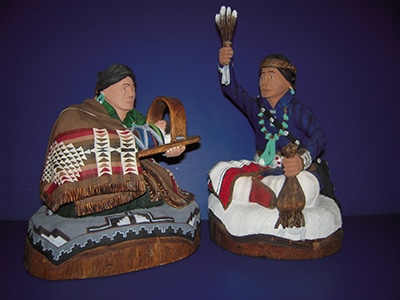Jesus, the Son of God, was born and lived in a particular time, place and culture. So the four evangelists were keen to trace the historical details of the earthly life of the Son of God as they wrote the Gospels. For instance, St. Luke tells of the precise circumstances of Jesus’ birth when he recounts that, “Joseph too went up from Galilee from the town of Nazareth to Judea, to the city of David that is called Bethlehem, because he was of the house and family of David, to be enrolled with Mary, his betrothed, who was with child. While they were there, the time came for her to have her child, and she gave birth to her firstborn son. She wrapped him in swaddling clothes and laid him in a manger, because there was no room for them in the inn” (Lk 2:4-7).
While Jesus’s earthly life unfolded in time in a particular place and culture, his saving mission was universal. At the heart of Jesus’ preaching was the coming of God’s kingdom on earth with the divine invitation extended to all people transcending time, place and culture. It is this central truth of Christianity that painters, sculptors, musicians, poets and writers have sought to translate into artistic forms for over 2,000 years.
Christian art from diverse cultures transcend the traditional imagery we are accustomed to seeing in churches, museums and online galleries. In such images we discover how artists across cultures and time bring to life in diverse visual forms the incarnation of God that stands at the heart of Christian faith.
1. “Holy Family” — Eddy Nyagweta, Zimbabwe

African artists from the Shona Tribe in Zimbabwe create their sculptures from locally sourced springstone, a serpentine stone found in natural form in rock mines across the country. In this bas-relief sculpture of the Holy Family by Zimbabwean sculptor, Eddy Nyagweta, we see the three figures of Jesus, Mary and Joseph emerge from dark stone framed by textured haloes carved into the natural rock. Part of a sculptural group commissioned by Hans Dietrich Huebert in Germany, this work is now part of a collection in the Knights of Columbus Museum in New Haven, Connecticut.
The stone bas-relief draws us into the intimacy of the Holy Family in their unity around God’s greatest gift in the Incarnation of his divine son, Jesus. We see Joseph enfolding his wife and divine child with strong tenderness as he fulfills his God-given, unique role as guardian of the redeemer and as the husband of Mary. The infant Jesus clings tightly to his mother Mary, who cradles his divine head in her hand. With their eyes closed and their serene facial expressions, Jesus, Mary and Joseph invite us into their intimate space where we, too, may contemplate the central mystery of Christian faith — that the God who is love took human form in Jesus, the humble child of Bethlehem. The divine love that knit the Holy Family together is offered to all people through the family of the Church.
2. “Navajo Holy Family” — Felix Yazzie, Arizona

For decades, James Govan and his late wife, Emilia, were thoughtful art collectors of Nativity scenes from around the world. In 1998, while traveling through the Southwest, they searched for Christmas creches created by Native Americans. Driving through Chinle, Arizona, the Govans noticed a Catholic Church in honor of Our Lady of Fátima. Through the kindness of the pastor of the parish, Father Blane Grein, they were able to commission a Native American carver, Felix Yazzie, to create a Nativity set for their collection.
It took over a year for the nativity set to be completed as the artist came into town to deliver one carved wooden sculpture at a time to the pastor. On receiving the last piece of sculpture, Father Grein sent the completed Nativity scene to the Govans, who consider the work among the most finely carved nativities in their collection. Today, most of the Govan’s collection of 565 nativities is in the care of the Loyola University Museum in Chicago. As Govan notes, “I view the collection as something created by people all over the world. … Emilia and I were/are only caretakers of a collection created as a gift by all this humanity.”
The figures of Jesus, Mary and Joseph are carved in wood, painted in bright flesh tones and covered in intricate Navajo textile patterns. Mary holds a wooden cradle with the baby Jesus wrapped in a Navajo blanket patterned in vibrant blue, green and red stripes. Mary’s frame is enveloped in a fringed Navajo patterned textile blanket, also carved and painted in wood. The figure of Joseph is alive with motion as he holds in his right hand, in a gesture of blessing over the divine Child, a carved spray of eagle feathers, which is a symbol of honor, strength and power, and highly prized with meaning in Navajo culture. Joseph is dressed regally with an ornate beaded necklace around his neck and a filled satchel in his left hand, evoking his care for the needs of the Holy Family. The faces of Mary and Joseph radiate joy in the divine child entrusted to their care. They invite us to share in their humble joy that fills the Church’s entire liturgical year.
3. “Our Lady of China” — John Lu Hung-Nien, China

Pilgrims visiting the monumental Byzantine-Romanesque Basilica of the National Shrine of the Immaculate Conception in Washington, D.C., journey through over 80 chapels and oratories where mosaics and sculptures express the cultures of various Catholic communities in their devotion to the Blessed Virgin Mary. In the west nave stair hall of the Great Upper Church, one unique mosaic, an image of Our Lady of China, reflects the devotion of Chinese American Catholics.
Completed in Venetian glass mosaic, the image, handcrafted in Northern Italy, is a copy of a painting of Our Lady of China by artist John Lu Hung-Nien, a convert to Catholicism. The image became well known when Thomas Cardinal Tien Ken-Sin, the first cardinal of China, used the painting on a holy card. Following his exile, the cardinal continued to encourage prayers for the Church in China through devotion to the Blessed Virgin Mary visualized in the painting.
Against a deep sky blue background we see the full length figure of Mary who is robed in traditional Chinese garments decorated with flowers and red and green ribboned tassels that fall in flowing movement around her. The Christ Child is dressed in a regal robe of bright red. Their heads are enclosed in a large golden halo as Mary stands amid billowing clouds that move across the scene. Two young birds carry flowers to honor the Madonna and child. In a panel of gold mosaic below are the words “faith,” “hope,” “charity” and “unity” written in Chinese characters.
Mary’s serene, delicate face is framed by a translucent veil around her face that cascades in gentle movement around her shoulders. The Mother of God radiates motherly tenderness as she gazes at her son, Jesus, who she holds close to her. The hands of the infant Jesus reach out to embrace his mother as he looks directly at the viewer inviting us to share in the maternal love and protection of his mother.
4. Madonna and Child with saints mural — Enzo Selvaggi, California
A mural of the Black Madonna, created for the 2017 National Black Catholic Congress, evokes the universal call to holiness in the lives of African American saints and holy men and women of every land and language through time. The mural is the work of Enzo Selvaggi, a California artist, and his team of artists painting in the Beuronese style. This late 19th century artistic style rooted in harmony, rhythm and symmetry was developed by a monk, Desiderius Lentz, and named after the Benedictine Abbey in Beuron, Germany.

At the center of the composition we see Mary as the Virgin of Wisdom, robed in a regal blue robe, and seated on a throne with the Christ Child in her lap. The Madonna’s hands are raised in a gesture of prayer as she looks tenderly at her divine son who offers a blessing to the communion of saints who offer praise and worship to her son, the child, Jesus. The stars in the blue field above them represent the constellation of the communion of saints, the flower stalks are Congolese, and the magnolia blooms refer to the Stono River Basin in South Carolina. The words “She took off her widow’s garb to raise up the afflicted in Israel,” from the book of Judith (16:7) echoes the praises of the people of God as they rejoiced in their freedom from cruel and powerful oppressors.
Around the Madonna and Child we see a heavenly court of saints, some canonized, others in the canonization process and others who are exemplary witnesses to holiness: St. Charles Lwanga, St. Katherine Drexel, St. Martin de Porres, St. Josephine Bakhita, Servant of God Thea Bowman, Venerable Henriette Delille, Servant of God Mother Mary Lange, Venerable Augustus Tolton, Father Cyprian Davis and Venerable Pierre Toussaint, among many others. Through their worship of the Christ Child and the honor they give to the Blessed Mother they invite us, the viewer, to join in the Church’s hymn of joyful praise.
5. “The Holy Family” — Sister Mary Charles McGough, Minnesota

Benedictine nun, Sister Mary Charles McGough spent most of her religious life in the St. Scholastica Monastery in Duluth, Minnesota, as an artist creating woodcuts, icons, watercolors, sculptures, ceramics, fabric banners and graphic designs. While Sister Mary Charles is best known for her icons depicting saints and biblical figures, her artistic work spanned a wide range of subjects and decorated local churches, homes and public spaces. She was a beloved art teacher known for her engaging summer art programs for children.
In this woodcut of the Holy Family created for Holy Family Church in Duluth, we see the figures of Jesus, Mary and Joseph clustered closely together. All three figures are framed by golden haloes with bright, piercing eyes that look directly at the viewer. One cannot remain an outside spectator. Rather the gazes of Jesus, Mary and Joseph invite us into that Gospel scene evoked in this poignant image. It is the story of the journey of the Holy Family to Jerusalem for Passover and the finding of the boy Jesus in the temple, recounted at the end of the second chapter of the Gospel of Luke (cf. 2:41-52).
In that Gospel story we are told that Jesus, now a 12-year-old boy, remained in Jerusalem while his parents, Mary and Joseph, returned home. They were not aware that Jesus had stayed behind. Then having looked frantically for Jesus for three days, they returned to Jerusalem. There they found him in the Temple, sitting among the teachers of the law, listening to and asking them questions. As we see in this image, the boy Jesus now in his “Father’s house” confidently holds the scroll of the Law. One day he will fulfill the Law in his own person and through his saving suffering, death and resurrection to reveal in visible form the invisible God who is love.
6. “Tree of Life” — Eva Campbell, Bulgaria

In a family workshop outside of Sofia, Bulgaria, Eva Campbell and her husband Alex create original works of art in acrylic, ink, watercolor and pastels. Their paintings and crafts, found in collections around the world, are inspired by Eastern iconography, early Christian art, folk art, and Asian Indian art and costumes.
In this print from an original painting titled “Tree of Life,” we see three luminous figures of Jesus, Mary and Joseph painted in a non-traditional style, evoking Eastern Orthodox iconography. The original painting on paper was created in bright colors of red, ochre and black. A young, bearded Joseph, clothed in a golden robe, holds the sleeping infant Jesus close in his arms, as Mary cradles her divine son’s head in her right hand. The serene face of the child Jesus reflects the peaceful communion of the Holy Family. Mary, dressed in a bright red belted robe, looks outward while Joseph gazes tenderly at the holy child in his arms. The elongated faces of Mary and Joseph, typical of Eastern iconography, create an otherworldly, ethereal space. The gently inclined heads of Jesus, Mary and Joseph enclose a triangular space out of which emerges a massive tree of life branching out in multiple directions. Two lively birds, perched on branches of the vibrant tree evoke the divine love that extends out into the world from this sacred family.
7. “Saint Joseph and the Christ Child” — Cusco School, Peru

In the late 17th to 18th centuries, as Christianity spread across the Americas, a new artistic language developed from the blend of European painting techniques and native artistic traditions among the Incas. One center of flourishing religious artistic creativity emerged in Cusco, Peru, the former capital of the Inca Empire. In the “Cusco School,” Andean artists adapted European painting techniques, learned from Spanish missionaries, in a distinct style of religious art rich in color, elaborate clothing and fine adornment. This painting of “Saint Joseph and the Christ Child,” now in the Brooklyn Museum, is an exquisite example of devotional art, created by Andean artists, that flourished across South America in the 1700s.
The central subject of this painting is a youthful St. Joseph, dressed in a richly embroidered royal garment reflecting the highly prized textiles of the Inca people. Joseph holds the hand of his foster son, Jesus, focusing attention on his paternal role as guardian of the redeemer. The Christ Child’s elaborate garments match his foster father’s clothes, adorned with intricate gold stamping on the cuffs, hem and lace trim. His bright red sandals echo the footwear worn by elite members of indigenous Inca communities. In his left hand, Joseph holds a stem of three lilies, his traditional artistic attribute pointing to his marital chastity as the spouse of the Blessed Virgin Mary. Tender images, such as this 17th century painting, invite us during this Year of St. Joseph to contemplate the unique relationship between the Child Jesus and St. Joseph, the humble carpenter of Nazareth to whom God entrusted the care of his only divine son, Jesus.
Our pilgrimage through this selection of diverse artistic depictions of the Holy Family takes us beyond the traditional canon of images. The rich history of cultures inspiring each image is a reminder that faith in Jesus Christ unites people of every race and language into the one family of the Church. We profess our belonging to this community in the universality of faith as we pray the words of Creed each Sunday: “I believe in one, holy, catholic and apostolic Church.”
Jem Sullivan, Ph.D., teaches Catechetics in the School of Theology and Religious Studies at The Catholic University of America, and is the author of “The Beauty of Faith: Christian Art and the Good News” and “Believe, Celebrate, Live, Pray: A Weekly Walk with the Catechism” from Our Sunday Visitor.







